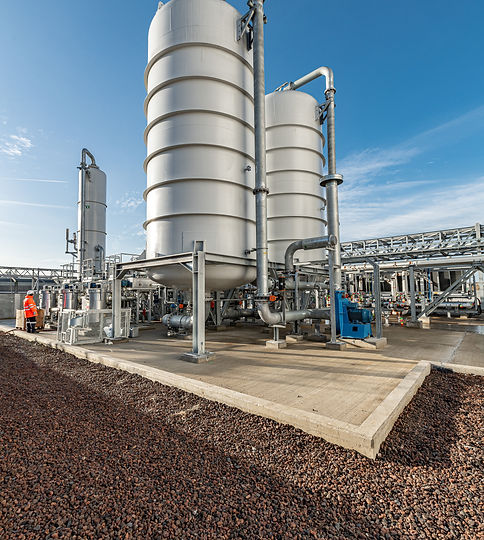High VOC Concentration Vapour Recovery Units
VOCZero's
Distribution Terminal Line DTL™
Vacuum regenerated Activated Carbon VAC™
VOCZero supplies a range of Vapour Recovery Units (VRU) for recovery of medium to high concentrations of volatile organic compounds from vapours.
The process is based on the well-known technology of adsorption on activated carbon and regeneration of the activated carbon by vacuum. This technology has proven to be the best available for applications like storages, truck, rail, barge and ship loading operations.
The design and selection of parts are made to achieve a durable, safe and efficient process plant, and are based on international standards recognised in the oil and gas industry, such as ASME VIII, ASME B31.3, EN 60079 & EN 1127.

The typical vapours to be treated are:
-
Gasoline
-
Diesel
-
E5-E100 Gasohol (Ethanol)
-
Methanol
-
Benzene
-
Toluene
-
Xylene
-
MTBE
-
ETBE
-
Naphtha
-
Reformate
-
Crude Oil
-
Gas Condensate
The VRU’s are designed to meet the stringent health and safety requirement set out by European ATEX and Machinery directives.
The VRU's can as standard be delivered configured for the hydrocarbon emission listed here (TOC excluding methane) or alternatively configured for project specific emission levels.
-
120 mg/Nm³
-
150 mg/Nm³
-
10 g/Nm³
-
17 g/Nm³
-
35 g/Nm³
-
35 g/m³ loaded product
-
20. BImSch Verordnung
Key features
-
Modular design
-
Prefabricated piping and steel makes installation simple
-
Energy efficient

.jpg)
PROCESS DESCRIPTION
The process is based on separation of gasses using activated carbon. The mixture of air and hydrocarbon vapour is lead to a carbon filter, where the hydrocarbon is retained by adsorption on the carbon, and the clean air passes through the vent to the atmosphere. VZ DuraVOC™, a special selected durable and safe activated carbon is used in our filters.
After a period of typically 10 to 15 minutes, the carbon is saturated with hydrocarbons, and the hydrocarbon emission increases slightly. A hydrocarbon analyser in the vent detect this, and the control system switches the filter from receiving vapour to regeneration mode.
Vacuum is applied to the filter and strips off the recovered VOC vapour from the carbon. The stripped off hydrocarbon vapour is then lead to an absorption column, where the hydrocarbon is condensed in a stream of gasoline, or a similar product available in the terminal. While one filter is being regenerated, the other filter is receiving the mixture of air and hydrocarbon vapour.

Courtesy Aerzen Machines Ltd.


OPTIMISED VACUUM SYSTEMS
As standard, the vacuum system in the DTL™ series VRU consists of rotary vane vacuum pumps, which have the lowest energy consumption among vacuum pumps. Upstream the vacuum pump, Roots blowers are installed as boosters to the vacuum pumps. Roots blowers are characterized by being able to transport large vapour volumes, over a relatively modest pressure range, highly energy-efficient.
In the DTL™ VRU's, Roots blowers evacuate VOC vapour from the activated carbon, in the pressure range 50 to 200 hPa. At 200 hPa, the VOC vapour volume is compressed to approx. the half of the volume it makes out at 100 hPa. This requires a vacuum pump with only the half vapour capacity operating from 200 hPa, in comparison to if it operates from 100 hPa.
For further information please read the article: Potential energy savings and optimisation of VRU's.pdf >>
DTL™ Series Product Range


ENERGY EFFICIENCY
VOCZero's vapour recovery units offer the lowest power consumption available in the market. Not only are there significant savings in operation, but great savings on installation costs, such as power supply and cable installation are achieved.
*Power usage for a typical gasoline truck loading VRU

